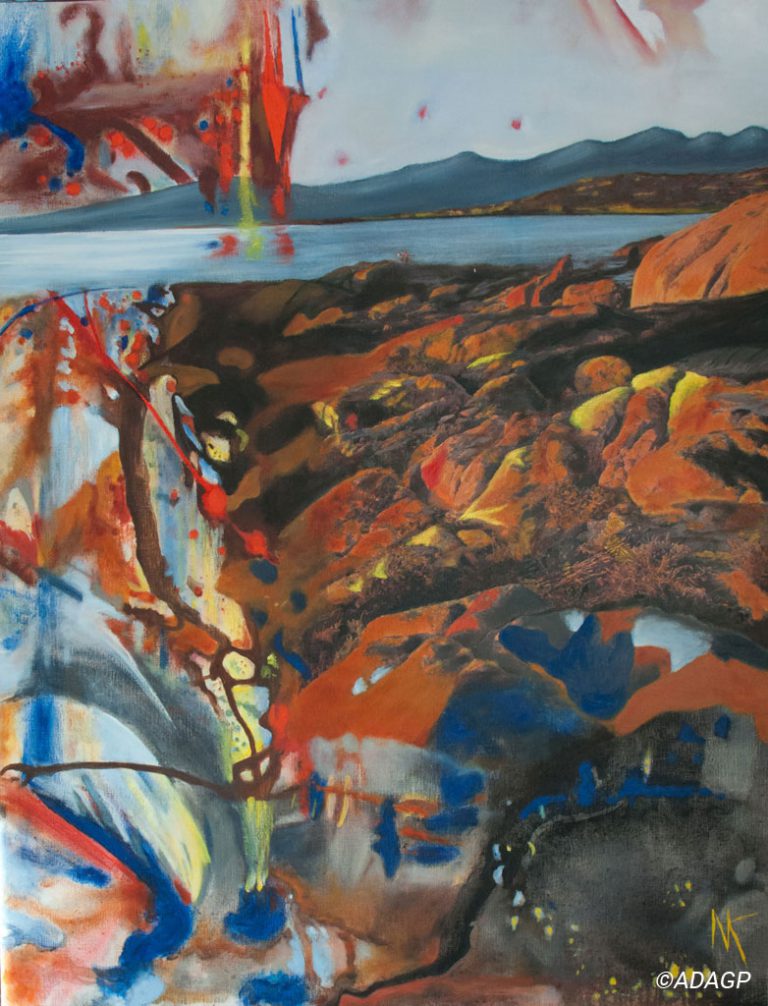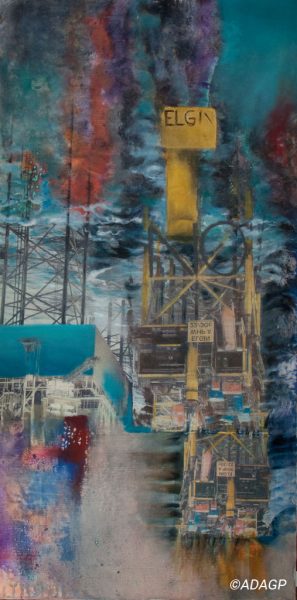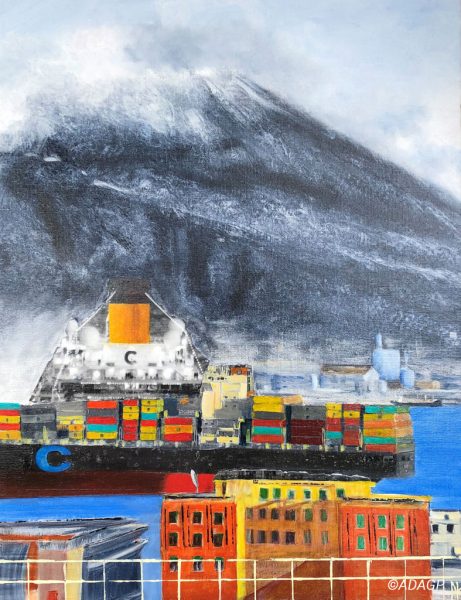
Nicole King’s artistic research revolves around her concern for the fragile state of our aquatic ecosystem. She uses mixed media techniques that allow for the highest quality of presence with an economy of means.
Recurrent ecological disasters
Nicole King’s experience as an environmental engineer working on offshore oil fields helps to raise key issues in her paintings which are inspired by the recurring environmental disasters.
In 2021, Nicole exhibited at the IUCN World Congress. She repeatedly makes the point of the vast potential when the two disciplines of art and science work together to protect nature’s beauty.
20 April 2010, Gulf of Mexico Deepwater Horizon
Triptych proposed by Nicole King for the COAL 2011 project (international call for tenders Art and Ecology).
To create this contemporary work of art, Nicole King invented a technical process: she taped blue plastic garbage bags onto her canvas frames to symbolise water and black to denounce our dependence on oil. After coating the area to be painted, she worked with oil paint.
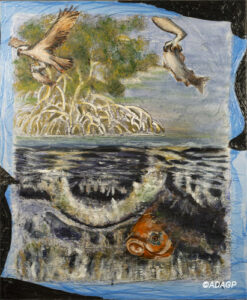
1: Before the disaster
The coastal mangrove system is very sensitive to pollution. The aerial roots, which ensure their respiration, are threatened all over the world. (IBPES* says only 25% of the mangroves remain viable today.)
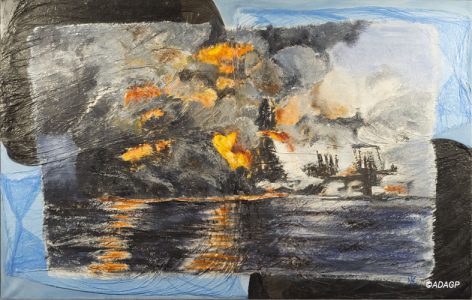
2: The explosion
Platform on fire, smoke and furnace at sea. BP will be responsible for the biggest oil spill of all time. 4,000,000 barrels and 11 deaths.

3: After the disaster
Oiled birds (6114 – estimate of the American Council for the Defense of Natural Resources-), views of children of the world.
*IPBES: international platform for biodiversity and ecosystem services
The ocean is taken hostage: Explosion of the British Petroleum (BP) Deepwater Horizon oil platform on the Macondo well in the Gulf of Mexico: the biggest oil pollution at sea of all time, 60,000 barrels/day released over 3 months, i.e. 4,000,000 barrels, and 11 deaths. In addition, BP spilled 5,000,000 litres of toxic dispersants into marine ecosystems. The cascading effects in the food chain were devastating, even if few impacts were mentioned in the press and world media – more than 6,000 oiled birds, thousands of dead animals (turtles, cetaceans, including hundreds of adult and newborn dolphins washed up on the beaches in early 2011…), 25 km of coastline polluted by the oil slick. The bayous, fragile ecosystems, can take twenty or thirty years to recover their natural state. Thousands of square kilometres were closed to fishing. (Ref. biblio. Project Coal 2010 by Nicole King).
The scale of the pollution in the Gulf of Mexico should have led to the imposition of international rules through a monitoring body under the auspices of the United Nations. However, the impacts were minimised and the visual media coverage was very limited. (Ref. biblio. Editorial in Courrier de la Nature no 256 Sept-Oct 2010 “One year on, the tide is still black”).
British Petroleum, in order to satisfy our ever-increasing energy needs, continues to drill ever deeper. The responsibility for the disaster lies not only with technical failures but also with political decisions conditioned by our lifestyle at the expense of respect for the environment. (See also Arne Naess, philosopher of Deep Ecology).
Our economy and our lifestyle must urgently integrate long-term environmental impacts.
The Deepwater Horizon disaster would not have happened if the BOP (Blow Out Preventer) had been independently monitored: it should have been better sized and in good working order.
2 March 2011, Fukushima, Japan
This painting evokes the effect of the Fukushima disaster on a symbolic coastal area: the fragile ecosystem of the Spano natural reserve in Corsica. The tension between the abstract part of the painting on the left and the figurative part on the right suggest the crisis and destruction of the marine and coastal environment.
In Japan, in March 2011, the tsunami wave broke over the plant’s surrounding wall to drown the electrical circuits of the cooling system of the Fukushima nuclear power plant. Irresponsible political decision-makers have allowed nuclear reactors to be built in a highly seismic area, which have now become totally uncontrollable: the continuous release of radionuclides into the Pacific Ocean over the last ten years constitutes a global risk and demonstrates once again the sacrifice of the safety of the population and the environment for the benefit of the short-term economic priorities.
Japan has just announced that in 2021 its storage capacity for radioactive water will be saturated and it will have to dump large quantities of contaminated water back into the Pacific Ocean. The fish will again be unfit to eat.
This painting evokes the imagined effect of the Fukushima disaster on a symbolic coastal area: the fragile ecosystem of the Pointe de Spano in Corsica.
25 march 2012, Explosion of Elgin
Nature disfigured by industrial activities can no longer be painted as before. To avoid any performative paradox, Nicole King chooses to represent technology in her images by using photography, combined with painting, a natural ecological gesture.
Here the platform explodes, pulverized by the force of the ocean, caused by the drilling.
Explosion of Total’s North Sea gas platform, Elgin: 200,000 m3 of gas. Natural gas and condensates were emitted into the atmosphere every day for 3 months, then partially plugged, but not shut off definitively until October 2012. It was again the safety valve at the bottom of the well that failed (Ref. biblio. Le Monde of 8 March 2013, P.13 “Total can resume gas extraction on Elgin”).
Since Deepwater Horizon, no lessons have really been learned from this disaster. The oil industry has been under-penalized (fines, reputation) if one calculates into the equation the irreparable environmental damages their ecological disasters provoke. In the North Sea, it was Total’s turn to lose control of a gas well for six months due to a lack of compliance with safety standards and external control. (Ref. biblio. WWF International Discussion paper “Lessons to be learned from the environmental consequences of the Persian Gulf War” by Nicole King-Volcy – 1991).
The cargoes of overconsumption
23 March 2021: The container ship EVER-GIVEN runs aground in the Suez Canal
The 220,000 ton cargo ship from China (20 stories high and 400m long) was blocking the international shipping crossroads in the Suez Canal (Egypt), which alone accounts for between 10% to 12% of the world’s total trade volume.
27 May 2021: MV X- Press PEARL, another cargo ship catches fire off Sri Lanka
This 186m long container ship with 1,500 containers including 25 ton of nitric acid and other chemicals and 28 containers of plastic materials spilled into the sea, polluting the beaches and condemning 80km of coastal areas to fishing.
In reference to these repeated disasters, Nicole King has painted “The Cargo of Overconsumption” (Naples, 2021), which denounces our unbridled and globalised consumption symbolised by two giant ships: the cruise ship in the background and the container ship in the foreground.
Such disasters highlight the issue of decision-making: neither scientists, nor politicians, nor the invisible hand of the economic market are up to the task of preventing the recurrence of such events. We cannot wait for the occurrence of irreversible imbalances to invent new economic strategies that require more environmental regulation and a more meditated approach to our respect for nature.
Artistic expression has a role to play in revealing the tensions of our time. Nicole King has chosen to paint in a way that integrates the time lived and stimulates the viewer to take the time to penetrate the painted work and thus deepen their reflection on the current ecological crisis.



